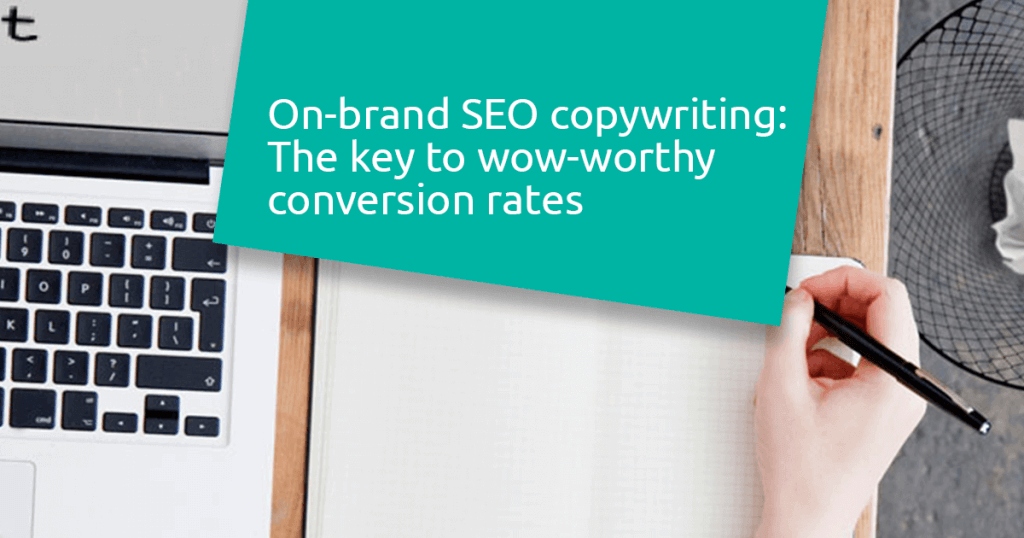Do you feel like your web pages aren’t driving as many conversions as you’d originally expected them to?
This dilemma is one of the most common frustrations experienced by brand managers and business owners. You’d set up a great website, rolled out a bunch of blog posts, gotten your SEO covered, and done your share of promoting content. So why aren’t you seeing the wow-worthy results you were envisioning?
The answer may be because you lack this one vital component of content writing: on-brand SEO copywriting.
Why is on-brand content so important?
These days, it’s simply not enough to drive traffic to your site or promote your blog posts on social media. Building a genuine connection with your audience and earning their trust is the key to presenting your brand (or your client’s brand) as a worthy products or services provider in the eyes of consumers.
Banking on on-brand SEO copy is what will bridge the gap between getting potential customers to visit your website and getting them to actually make a purchase or set up an appointment.

But wait, what exactly is on-brand SEO copy and how do I create it?
Great SEO copywriting goes beyond writing with search engines in mind. It’s not writing solely for your prospective clients, either. It’s the perfect marriage between these two elements, and it enables you to appeal both to Google and your target audience.
Forget about merely plugging in keywords and calling it a day. Creating content that speaks to your audience and leads them to accomplishing your desired action is what will propel you to success.
The truth is, if you’re actually writing rich, high-quality, and informative content, it’s most likely going to end up SEO-friendly anyway. All you’ll really have to do, then, is to make sure that the specific keywords you’re using are of the search traffic and competition level that you’re aiming for.

To optimise content for conversion, incorporating branding into your SEO copywriting strategy will help a great deal. It influences how you write. It lets you have a clear vision of who you’re writing for and enables you to compose better based on the action that you want your target audience to take.
Of course, before doing any of this, you have to zero in on your brand message.
Finding your brand message: Important questions to ask
Defining and establishing your brand message is one of the most forsaken steps in the business.
“Forsaken? What do you mean forsaken? I’m pretty sure I’ve worked on this.”
Maybe you have indeed. Or maybe… you haven’t done enough.
Perhaps you’ve studied the market, defined your target audience, and identified the specific problems you’re trying to address with your product. But ask yourself: have you rolled all of it together in one solid, cohesive message?
Knowing what your audience is generally like and identifying the market you’re playing into isn’t enough. You have to get into the nitty gritty and really home in on the specifics. Settling with broad ideas leads to content that reads flat. If you don’t zero in on the distinct elements that make your brand what it is, you risk sounding and looking like a generic brand that doesn’t really know what it’s doing and who it’s for.

This usually leads to lost opportunities. Generic-sounding content makes it hard for clients to form a connection with your brand. And when this happens, you can’t really expect them to convert, can you?
So work on your brand message ASAP. To help you do this, here are some essential questions for you to answer. Answer them, and you’re well on your way to figuring out the best brand message for your target audience.
Who is your ideal client?
This might be one of those “obvious” questions—but the fact is, people rarely give this question to amount of attention that it rightfully deserves.
When business owners are asked to think about this, they usually give generic answers like “digital marketers” or “small-scale entrepreneurs.” However, it’s important to dig deeper and create a more holistic profile of your target customers. You can do this by asking more questions, such as:
- What specific kind of entrepreneurs are they?
- What are their interests?
- What are the common problems they face?
- What are they like in terms of personality or behaviour?
- What tone or style of writing appeals best to them?
The more you know about these people, the easier it gets for you to formulate a brand message (and consequently, SEO content) that will really strike them to the core.
What value does your business provide to its customers?
No matter how convincing you think “more money” or “the best product in the entire universe” may sound, you have to think beyond the superficial when defining what value your business offers.
For example, it could be the convenience of outsourcing their social media management needs or the reassurance that comes with working with a tried-and-tested advertising agency.
Money is always going to be a part of the equation—but it’s not necessarily always going to be the main dish.
What makes your product unique?
In order to stand out from the competition, you have to determine what it is exactly that sets you apart.
Are you a content provider? Maybe you’re different because you offer unlimited revisions. Or if you’re in the congested world of consumer goods, maybe your product is unique because it’s strictly locally-sourced.
Whatever it is, capitalising on that one unique trait helps you attract the kind of audience that is enticed by your offer.
What are the different problems being solved through your products?
When answering this question, avoid coming up with statements like, “My client needed Product X. I sold him one and now his needs are met.”
An example of a more helpful answer is, “My client needed high-speed and dependable internet to be able to work from home, so I provided him with a premium-quality and high-speed connection at an affordable price.”
This approach lets you recognise a more specific problem and the way in which you addressed it. Try making a list of your clients’ most popular pain points and how your business helped them. This can give you ideas for future content on your site.
What is the number-one goal you’re trying to achieve with your site?
To be able to optimise your content for conversion, you have to figure out the exact type of conversion you’re gunning for. Is it:
- Getting them to subscribe to your blog for helpful info?
- Getting them to make a purchase on your sales page?
- Getting them to schedule a consultation with you?
All of these end results call for different variations of your brand message. Decide on one and optimise your on-brand content accordingly.
Conclusion
In conclusion, brand messaging can have a huge impact on how well your website converts. SEO content writing may bring loads of people into your site, but it is through using on-brand copywriting that you’ll be able to actually seal the deal.
If your webpages are able to drive traffic but are lacking the amazing conversion figures that you’re after, it could be that you have to work on your brand message a bit more. Follow the tips mentioned above and incorporate your brand message into your content. Pretty soon, you’ll see the results that you deserve.

